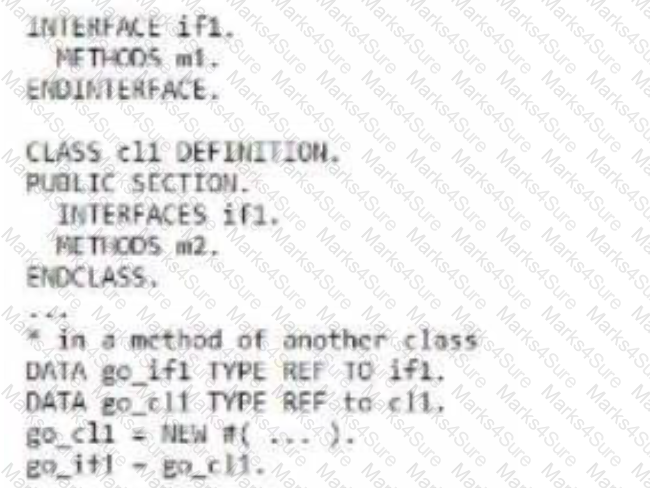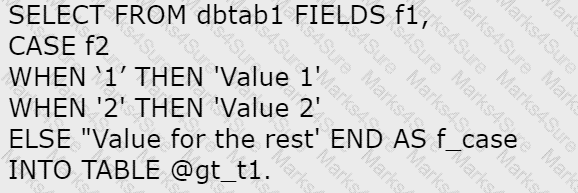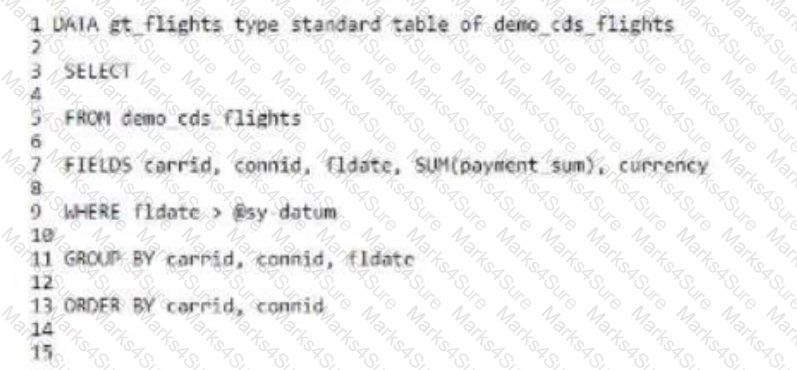Which of the following integration frameworks have been released for ABAP cloud development? Note: There are 3 correct answers to this question.
What are some features of a unique secondary key? Note: There are 2 correct answers to this question.
Which of the following ABAP SQL statements are valid? Note: There are 2 correct answers to this question.
Exhibit:

What are valid statements? Note: There are 3 correct answers to this question.
In which products must you use the ABAP Cloud Development Model? Note: There are 2 correct answers to this question.
What would be the correct expression to change a given string value 'mr joe doe' into 'JOE' in an ABAP SQL field list?
In the following ABAP SQL code, what are valid case distinctions? Note: There are 2 correct answers to this question.
A)

B)

C)
D)

Which of the following are incomplete ABAP types? Note: There are 2 correct answers to this question.
You want to define the following CDS view entity with an input parameter:
Define view entity Z_CONVERT With parameters currency : ???
Which of the following can you use to replace "???? Note: There are 2 correct answers to this
question.
In class ZCL_CLASS_A, you use the statement DATA var TYPE ***
What may stand in place of ***? Note: There are 2 correct answers to this question.
You are designing the following select statement in ABAP Open SQL:

To adhere to the most recent ABAP SQL syntax conventions from SAP, on which line must you insert the "INTO TABLE @gt flights" clause to complete the SQL statement?
Which of the following are parts of the definition of a new database table?Note: There are 2 correct answers to this question.
Given the Code:
INTERFACE if1.
METHODS m1.
ENDINTERFACE.
CLASS cl1 DEFINITION.
...
INTERFACES if1.
ENDCLASS.
CLASS cl2 DEFINITION.
...
DATA mo_if1 TYPE REF TO if1.
ENDCLASS.
What are valid statements? (Note: There are 3 correct answers to this question.)
Setting a field to read-only in which object would make the field read-only in all applications of the RESTful Application Programming model?
Class super has subclass sub. Which rules are valid for the sub constructor? Note: There are 2 correct answers to this question.
Which type of legacy code does SAP recommend you eliminate when you review modifications as part of an SAP S/4HANA system conversion? Note: There are 2 correct answers to this question.
In a test method you call method cl_abap_unit_assert=>assert_equals( .. ) in the following way:
CLASS Itcl1 DEFINITION FOR TESTING RISK LEVEL HARMLESS DURATION SHORT.
PRIVATE SECTION.
METHODS m1 FOR TESTING.
ENDCLASS.
CLASS Itcl1 IMPLEMENTATION.
METHOD m1.
DATA: go_test_object TYPE REF TO zcl_to_be_tested.
CONSTANTS: Ico_exp TYPE string VALUE 'test2'.
CREATE OBJECT go_test_object.
cl_abap_unit_assert=>assert_equals(
EXPORTING
act = go_class->mv_attribute
exp = lco_exp
msg = 'assert equals failed ' && go_test_object->mv_attribute && ' ' && lco_exp
ENDMETHOD.
ENDCLASS.
What will happen if method parameters act and exp are not equal?
In a RESTful Application Programming application, in which objects do you bind a CDS view to create a value help? Note: There are 3 correct answers to this question.
You have attached a system field to an input parameter of a CDS view entity as follows:

What are the effects of this annotation? Note: There are 2 correct answers to this question.